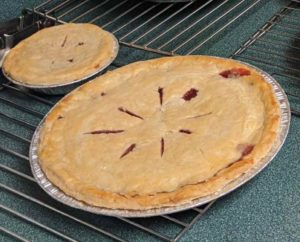EDUC 361: Curriculum and Instruction
My learning for this course culminated in a Helicopter Vantage Point View of Education assignment with Pie as a metaphor. The PowerPoint can be viewed through the following link: The Pie Ad-Vantage
My comparison suggests that pie can help explain education through elements of tools, ingredients, process, and culture.
One needs to start with the right tools. The pie plate is comparable to the Ministry of Education (provincial level) that provides rigid infrastructure and laws to keep people and ideas doing what they should. The rolling pin is then the District Superintendent, measuring utensils represent School Board and Councils, and the cutters and shapers are indicative of parents and students, teachers and principals, and teachers associations.

Crust
Ingredients can be broken down into three parts: crust, filling, and topping. The crust may be the most important, because although it may not be obvious from the finished product, everything else is built on this. Crust includes a base (shortening) which is comparable to the BC Teaching Standards, a filler (flour) symbolizing BC Curriculum, a binder (water) which represents First Peoples Principles of Learning and holds everything together, and flavor (salt) representing how we put them together. Although the crust is the foundation of pie, the filling embodies choice and variety, especially in its main attraction (fruit), so this stands for the Core Competencies because, as I understand it, these are the main desired outcomes of the schooling process. The thickening agent (corn starch) is then the Curricular Competencies, and the sweetener (sugar) is the Content. Again, the binder (water) for all of this is the First Peoples Principles of Learning. The topping is what it all looks like from the outside, so it looks different depending on what you are working with and what choices are made. Different aspects could be emphasized. This is signified by School, Community, Parents/Guardians, Elders, and
Local Experts all working together. In pie toppings, ingredients vary, but all should include some form of binding agent – you guessed it – First Peoples Principles of Learning.

Pie
As for the process, how both pie and education all go together is important, and the experience is different for everyone. Forget one ingredient, or don’t pay attention and you could end up with a lump of charcoal – like an educational disaster! So it is important to be mindful and aware of each element of the process, in both cases.
My favorite aspect, the culture of pie, relates to the culture of education in that sharing is the best part. One of the aspects that has surprised me about the educational field is the fairly free sharing of knowledge, resources, and strategies. Much like when bakers share recipes so that ourselves and others can have new experiences, develop skills, and accomplish more, we all want one another to succeed in the educational field.
References:
BC Teachers’ Council. (2019, June 19). Professional Standards for BC Educators. Province of British Columbia. https://www2.gov.bc.ca/assets/gov/education/kindergarten-to-grade-12/teach/teacher-regulation/standards-for-educators/edu_standards_poster-11×17.pdf.
First Nations Education Steering Committee (2008). First Peoples Principles of Learning. Teacher resource poster: English First Peoples. http://www.fnesc.ca/first-peoples-principles-of-learning/.
Province of British Columbia. (2021). BC’s Curriculum. https://curriculum.gov.bc.ca/.
Robson, K. L. (2019). The Structure of Education in Canada. In Sociology of Education in Canada. Pressbooks. https://ecampusontario.pressbooks.pub/robsonsoced/chapter/__unknown__-4/.

Leave a Reply